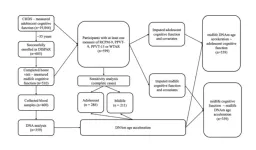(Press-News.org) East Hanover, NJ – June 25, 2024 – The employment-to-population ratio for individuals with vision impairments continues to show marked improvement, according to data shared during the according to last Friday’s National Trends in Disability Employment (nTIDE) Deeper Dive Lunch & Learn Webinar. nTIDE is a joint effort by Kessler Foundation and the University of New Hampshire’s Institute on Disability (UNH-IOD).
Director of Research Arielle Silverman, PhD, and Research Specialist Sarahelizabeth Baghun, PhD, from the American Foundation for the Blind (AFB) contributed their expertise to this edition of nTIDE, focusing on the unique challenges and opportunities in the labor market faced by people who are blind or have low vision.
“The employment of people with vision impairment is improving, which may be due to advancements in remote work and improvements in IT technology, making it easier for visually impaired individuals to be even more and more productive,” said nTIDE expert Andrew Houtenville, PhD, economics professor and research director at UNH-IOD.
Elaine E. Katz, MS, CCC-SLP, senior vice president of Grants and Communications at Kessler Foundation agreed, adding, “The continued improvement in employment rates for individuals with vision impairments is a testament to the positive impact of accessible technologies and workplace accommodations.”
The data indicates a strong recovery in employment for individuals with vision impairments following the pandemic. “While the first year post-lockdown saw a slower employment recovery, the subsequent periods have shown consistent increases,” said Dr. Houtenville. In the most recent 12-month period (spanning April 2023 to March 2024), the employment-to-population ratio was 63.9% for those who reported vision difficulties only, compared to individuals who reported general vision difficulties (42.2%) and individuals reporting any disability at 37.3%. In contrast, employment rates for those with hearing impairments have leveled off, and those with ambulatory difficulties have tapered, recounted Dr. Houtenville.
On the other end of the scale, the employment-to-population ratio of individuals who reported vision difficulties with activity limitations was 14.1%. “This data point highlights the importance of considering activity limitations alongside vision impairments and a more comprehensive understanding of the employment landscape for individuals who are blind or have low vision,” explained Dr. Houtenville.
In their presentation, Drs. Silverman and Baghun mentioned AFB’s Workplace Technology Study, which identified common friction points in the workplace of workers who are blind, have low vision, or are deafblind.
These individuals frequently faced accessibility challenges during hiring and onboarding, with about 25% unable to fully access required job trainings, impacting their productivity and sense of inclusion. They also encountered issues with mainstream technology tools, especially with video conferencing, instant messaging, and improperly formatted documents from sighted colleagues.
AFB’s latest study will uncover the biggest trends, risks, and opportunities with how artificial intelligence is changing the workplace should be available at end of calendar year. AFB is also collaborating with UNH-IOD on a section in the Annual Disability Statistics Compendium focusing on the population of people experiencing vision loss, a first in studying a co-curated section with disability type.
Note on Data Collection and Language: When presenting information about disabilities, nTIDE employs the terminology found in the survey that serves as the basis for BLS data, known as the Current Population Survey (CPS). nTIDE data is self-report data based on the CPS, and relevant to data for people with disabilities. nTIDE is funded by the National Institute on Disability, Independent Living and Rehabilitation Research (NIDILRR; 90RTGE0005) and Kessler Foundation.
Live Webinar on Disability and Employment
nTIDE is presented by Kessler Foundation and the University of New Hampshire’s Institute on Disability (UNH-IOD). In conjunction with each nTIDE report, experts host a 12:00 PM – 1:00 PM (ET) Lunch & Learn Webinar via Zoom featuring in-depth analyses, guest speakers, and news updates from the field. Webinars include invited panelists who discuss current disability-related findings and events.
Register for our next Deeper Dive Lunch & Learn Webinar on July 19, 2024, at ResearchonDisability.org/nTIDE where you can also access the archives for this Deeper Dive and previous nTIDE webinars.
About the Institute on Disability at the University of New Hampshire
The Institute on Disability at the University of New Hampshire was established in 1987 to provide a university-based focus for the improvement of knowledge, policies, and practices related to the lives of persons with disabilities and their families. For information on the Institute’s NIDILRR-funded Rehabilitation Research and Training Center on Disability Statistics and Demographics (StatsRRTC), visit ResearchOnDisability.org.
About Kessler Foundation
Kessler Foundation, a major nonprofit organization in the field of disability, is a global leader in rehabilitation research. Our scientists seek to improve cognition, mobility, and long-term outcomes, including employment, for adults and children with neurological and developmental disabilities of the brain and spinal cord including traumatic brain injury, spinal cord injury, stroke, multiple sclerosis, and autism. Kessler Foundation also leads the nation in funding innovative programs that expand opportunities for employment for people with disabilities. We help people regain independence to lead full and productive lives. For more information visit KesslerFoundation.org.
Citation: Kessler Foundation. (2024 June 25) nTIDE June 2024 Deeper Dive: Employment Trends for People with Disabilities Highlight Continued Gains for Those with Vision Impairments [Press release].
For more information, contact:
Deb Hauss, DHauss@KesslerFoundation.org
Carolann Murphy, CMurphy@KesslerFoundation.org
Stay Connected with Kessler Foundation
X (formerly known as Twitter) | Facebook | YouTube | Instagram | SoundCloud
END
nTIDE June 2024 Deeper Dive: Employment trends for people with disabilities highlight continued gains for those with vision impairments
Latest nTIDE report shows employment growth in vision-impaired population amidst broader disability employment trends
2024-06-25
ELSE PRESS RELEASES FROM THIS DATE:
WVU refining at-home sleep apnea detection device to help with more efficient diagnosis, treatment
2024-06-25
West Virginia University researchers will put a sleep apnea detection device at the fingertips or wrists of patients facilitating early diagnosis and treatment of the disease with support from a National Science Foundation grant.
Dr. Sunil Sharma, N. Leroy Lapp Professor and division chief of the Pulmonary, Critical Care and Sleep Medicine Fellowship Program in the WVU School of Medicine, received the award after working with other WVU researchers to develop prototypes and secure a patent.
“It’s about taking technology from the lab to the bedside,” Sharma said. ...
UC San Diego receives $5 million to support geriatrics workforce enhancement program
2024-06-25
The University of California San Diego has been selected for the third time to participate in the Geriatrics Workforce Enhancement Program (GWEP). This highly selective program comes with a $5 million grant from the Health Resources and Services Administration (HRSA). These funds will be used over the next five years to support the San Diego Imperial Geriatric Education Center (SDIGEC), which provides geriatric educational programming to health workers and other care providers across both San Diego and ...
Got prunes? Prunes may preserve bone density and strength in older women
2024-06-25
UNIVERSITY PARK, Pa. — Dairy isn’t the only food that’s good for bone health. Prunes may also protect bone structure and strength in postmenopausal women, according to a new study led by Penn State researchers. The findings, published in Osteoporosis International, suggest that daily prune consumption slows the progression of age-related bone loss and reduces the risk of fracture.
“This is the first randomized controlled trial to look at three-dimensional bone outcomes with respect to bone structure, geometry and estimated strength,” said Mary Jane ...
Associations of childhood, adolescence, and midlife cognitive function with DNA methylation age acceleration in midlife
2024-06-25
“[...] our study brings attention to the potential influence of adolescent crystalized intelligence on age-related DNAm at older age.”
BUFFALO, NY- June 25, 2024 – A new research paper was published in Aging (listed by MEDLINE/PubMed as "Aging (Albany NY)" and "Aging-US" by Web of Science) Volume 16, Issue 11, entitled, “Associations of childhood, adolescence, and midlife cognitive function with DNA methylation age acceleration in midlife.”
Prior studies showed increased age acceleration (AgeAccel) is associated with worse cognitive function among ...
Think you might have COVID? Wait two days to test
2024-06-25
Peek in medicine cabinets across the U.S. and you’ll find stacks of leftover COVID-19 tests.
When symptoms arise, so do questions: When should I test? How accurate is it really? And what should I do if I test positive?
In a paper published June 14 in the journal Science Advances, CU Boulder researchers unveil a new mathematical model to quickly answer such questions, not only for COVID but also for emerging rapid tests for respiratory syncytial virus (RSV), the flu and other infectious diseases.
One key takeaway: Advice can differ ...
Researchers develop new training technique that aims to make AI systems less socially biased
2024-06-25
CORVALLIS, Ore. – An Oregon State University doctoral student and researchers at Adobe have created a new, cost-effective training technique for artificial intelligence systems that aims to make them less socially biased.
Eric Slyman of the OSU College of Engineering and the Adobe researchers call the novel method FairDeDup, an abbreviation for fair deduplication. Deduplication means removing redundant information from the data used to train AI systems, which lowers the high computing costs of the training.
Datasets gleaned from the internet often contain biases present in society, the researchers said. When those biases are codified in trained AI models, they can serve to perpetuate ...
Backward walking speed reserve assessment offers improved clinical screening for risks and decline in MS patients
2024-06-25
DETROIT — Wayne State University postdoctoral research fellows Patrick Monaghan, Ph.D., and Michael VanNostrand, Ph.D., along with Nora E. Fritz, Ph.D., PT, DPT, NCS, director of the Neuroimaging and Neurorehabilitation Lab and associate professor of physical therapy in the Department of Health Care Sciences in WSU’s Eugene Applebaum College of Pharmacy and Health Sciences, recently published a study on mobility assessments in the journal, Multiple Sclerosis and Related Disorders.
The study, “Backwards walking speed reserve in persons ...
Clinical trial evaluates economic impact of changing how healthcare is delivered to older people in the emergency department
2024-06-25
The evaluation of the OPTI-MEND trial demonstrates that investing in an additional dedicated professional team to the already existing ED care increases patients’ quality of life and will save, on average per person, a staggering €6,128.
Crowding in emergency departments (EDs) is a growing problem in Ireland and internationally and, coupled with long waiting times, affects healthcare outcomes and patient satisfaction. A new study from researchers at Trinity College Dublin and University of Limerick examined the economic impact of adding a specific, appropriate, and dedicated team of professionals to the care already available ...
Uncovering the drivers of a million-year-old glacial transition
2024-06-25
The climate modeling community has been particularly vexed by the glacial/interglacial cycles of the past three million years, when the Northern Hemisphere oscillated between times with and without large ice sheets.
From about 1.25 million to 750,000 years ago—in the Pleistocene epoch—a change in glacial cycles called the Mid-Pleistocene Transition (MPT) occurred. During this time, glacial/interglacial cycles shifted from occurring every 41,000 years to every 100,000 years, with an increase in the amplitude and asymmetry of the cycles. Scientists are working to understand why these changes happened, considering that insolation forcing—variation ...
Surprising vortex behind new solar cell and lighting materials
2024-06-25
Metal-halide perovskites have quickly advanced in the last decade since their discovery as a semiconductor that outshines silicon in its conversion of light into electric current.
Simulations on TACC's Frontera and Lonestar6 supercomputers have revealed surprising vortex structures in quasiparticles of electrons and atoms, called polarons, which contribute to generating electricity from sunlight.
This new discovery can help scientists develop new solar cells and LED lighting. This type of lighting is hailed as eco-friendly, sustainable technology ...
LAST 30 PRESS RELEASES:
Hospitals acquired by real estate investment trusts associated with greater risk of bankruptcy, closure
City of Hope scientists study rare disorder to uncover mechanism and hormone regulation underlying fatty liver disease and sweet aversion
Your genes may influence gut microbiome of others, rat study shows
‘Personality test’ shows how AI chatbots mimic human traits – and how they can be manipulated
Global food systems driving twin crises of obesity and global heating
Osaka Medical and Pharmaceutical University researchers capture real-time molecular movies of enzyme catalysis
Could your genes influence the gut microbiome of others?
Clues to Alzheimer’s disease may be hiding in our ‘junk’ DNA
Study reveals that the body uses different sensors to detect cold in the skin and in internal organs
iPS cells from dish to freezer and back
Deep neural networks enable accurate pricing of American options under stochastic volatility
Collective risk resonance in Chinese stock sectors uncovered through higher-order network analysis
Does CPU impact systemic risk contributions of Chinese sectors? Evidence from mixed frequency methods with asymmetric tail long memory
General intelligence framework to predict virus adaptation based on a genome language model
Antibiotic resistance is ancient, ecological, and deeply connected to human activity, new review shows
Vapes, pouches, heated tobacco, shisha, cigarettes: nicotine in all forms is toxic to the heart and blood vessels
From powder to planet: University of Modena engineers forge a low-carbon future for advanced metal manufacturing
Super strain-resistant superconductors
Pre-school health programme does not improve children’s diet or physical activity, prompting call for policy changes, study finds
Autumn clock change linked to reduction in certain health conditions
AI images of doctors can exaggerate and reinforce existing stereotypes
Where medicine meets melody – how lullabies help babies and parents in intensive care
We may never be able to tell if AI becomes conscious, argues philosopher
AI video translation shows promise but humans still hold the edge
Deep ocean earthquakes drive Southern Ocean’s massive phytoplankton blooms, study finds
Without campus leftovers to pick through, the beaks of this bird changed shape during the pandemic
High-dose antibiotic does not reduce mortality in tuberculous meningitis
How many insects fly in the sky above the USA?
Could cheese protect your brain health?
Who faces more difficulty recovering from stroke?
[Press-News.org] nTIDE June 2024 Deeper Dive: Employment trends for people with disabilities highlight continued gains for those with vision impairmentsLatest nTIDE report shows employment growth in vision-impaired population amidst broader disability employment trends






